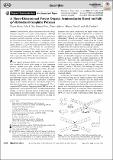| dc.contributor.author | Byun, Yearin | |
| dc.contributor.author | Xie, Lilia S. | |
| dc.contributor.author | Fritz, Patrick | |
| dc.contributor.author | Ashirov, Timur | |
| dc.contributor.author | Dinca, Mircea | |
| dc.contributor.author | Coskun, Ali | |
| dc.date.accessioned | 2020-10-26T21:13:18Z | |
| dc.date.available | 2020-10-26T21:13:18Z | |
| dc.date.issued | 2020-06 | |
| dc.date.submitted | 2020-05 | |
| dc.identifier.issn | 0044-8249 | |
| dc.identifier.issn | 1521-3757 | |
| dc.identifier.uri | https://hdl.handle.net/1721.1/128211 | |
| dc.description.abstract | Dimensionality plays an important role in the charge transport properties of organic semiconductors. Although three-dimensional semiconductors, such as Si, are common in inorganic materials, imparting electrical conductivity to covalent three-dimensional organic polymers is challenging. Now, the synthesis of a three-dimensional π-conjugated porous organic polymer (3D p-POP) using catalyst-free Diels–Alder cycloaddition polymerization followed by acid-promoted aromatization is presented. With a surface area of 801 m2 g−1, full conjugation throughout the carbon backbone, and an electrical conductivity of 6(2)×10−4 S cm−1 upon treatment with I2 vapor, the 3D p-POP is the first member of a new class of permanently porous 3D organic semiconductors. | en_US |
| dc.description.sponsorship | U.S. Department of Energy, Office of Basic Energy Sciences (Grant DESC0018235) | en_US |
| dc.description.sponsorship | National Science Foundation (Award 1122374) | en_US |
| dc.language.iso | en | |
| dc.publisher | Wiley | en_US |
| dc.relation.isversionof | http://dx.doi.org/10.1002/ange.202005069 | en_US |
| dc.rights | Creative Commons Attribution NonCommercial License 4.0 | en_US |
| dc.rights.uri | https://creativecommons.org/licenses/by-nc/4.0/ | en_US |
| dc.source | Wiley | en_US |
| dc.title | A Three‐Dimensional Porous Organic Semiconductor Based on Fully sp 2 ‐Hybridized Graphitic Polymer | en_US |
| dc.type | Article | en_US |
| dc.identifier.citation | Byun, Yearin et al. "A Three‐Dimensional Porous Organic Semiconductor Based on Fully sp 2 ‐Hybridized Graphitic Polymer." Angewandte Chemie 132, 35 (June 2020): 15278-15282 © 2020 Wiley | en_US |
| dc.contributor.department | Massachusetts Institute of Technology. Department of Chemistry | |
| dc.relation.journal | Angewandte Chemie | en_US |
| dc.eprint.version | Final published version | en_US |
| dc.type.uri | http://purl.org/eprint/type/JournalArticle | en_US |
| eprint.status | http://purl.org/eprint/status/PeerReviewed | en_US |
| dc.date.updated | 2020-10-21T15:22:09Z | |
| dspace.orderedauthors | Byun, Y; Xie, LS; Fritz, P; Ashirov, T; Dincă, M; Coskun, A | en_US |
| dspace.date.submission | 2020-10-21T15:22:14Z | |
| mit.journal.volume | 132 | en_US |
| mit.journal.issue | 35 | en_US |
| mit.license | PUBLISHER_CC | |
| mit.metadata.status | Complete | |
